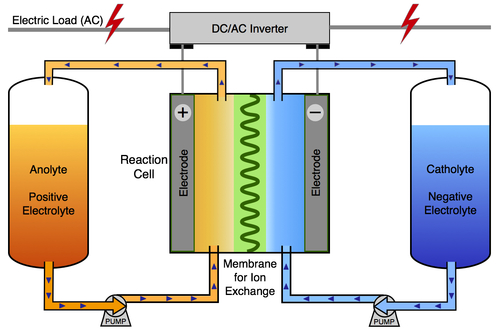The Achilles Heel of renewable energy is storage. Intermittent power sources such as wind and solar do not provide electricity exactly when needed. The sun does not shine during the night. Some days have too little wind, and some too much. To balance the load effectively it is either necessary to provide backup generation power (such as hydro or natural gas power plants), or find a way to store electricity. Solar thermal power plants can store some heat overnight (using molten salt), but it would be much more practical if one could use grid-scale batteries. Conventional batteries have too little capacity for providing grid-scale electricity storage. Flow batteries are about to change this picture.

The diagram above shows the basic concept of a flow battery, in particular, a redox flow battery (RFB). The name "redox" indicates that this battery uses chemical reduction and chemical oxidation reactions to store energy in liquid electrolyte solutions. During charging and discharging, ions (protons) flow across a membrane between the two half cells. The amount of energy that is stored depends on the volume of the electrolytes and thus can be scale up significantly. Unlike conventional batteries, energy is separated from power. Power is only released when the pumps deliver fluid trough the reaction cell. Different chemicals can be used as electrolytes. Common concepts involve iron-chromium, vanadium, and zinc-bromine. For example, a vanadium RFB is suitable for power systems in the range of 100 kW to 10 MW with storage durations in the 2-8 hour range.
‘Flow batteries can make grid-scale energy storage economical and boost the use of intermittent energy sources.’
Flow battery storage is starting to reach economic viability. Currently, the price of installed vanadium redox flow batteries hovers around $1,250 per KWh. This price is expected to drop to $750 in the next few years. About three quarters of the cost is attributed to materials and components, of which a third is the cost of the electrolytes. Some of the first commercial-scale operations are taking shape. The Japanese island of Hokkaido will host a new wind/solar farm with vanadium RFBs for storage. Bloomberg reported that Sumitomo Electric Industries will set up a 60 MWh battery system at the Minami Hayakita substation in Abira, which is said to be completed in March 2015. Flow batteries can make grid-scale energy storage economical and boost the use of intermittent energy sources. But applications are not limited to storing intermittent energy from wind and sun. There is also great potential for using vanadium RFBs for ‘frequency regulation services’—technical parlance for balancing supply and demand in a grid. A paper published in the journal Applied Energy finds that a vanadium RFB system has become cost effective for use in Texas's ERCOT grid.
We have reached an exciting new period for developing our electricity grids. New technologies such as vanadium RFBs can make large-scale grid storage technically feasible and economically viable. Watch an important new industry emerge in the next few years.
![[Sauder School of Business]](logo-ubc-sauder-2016.png)
![[The University of British Columbia]](logo-ubc-2016.png)